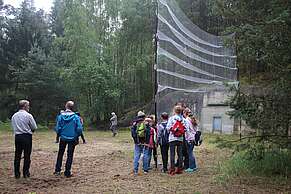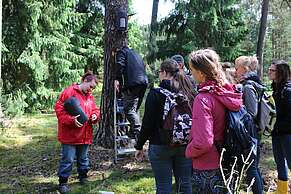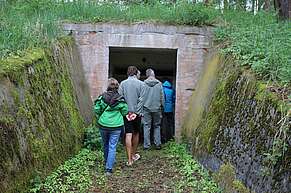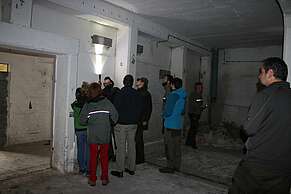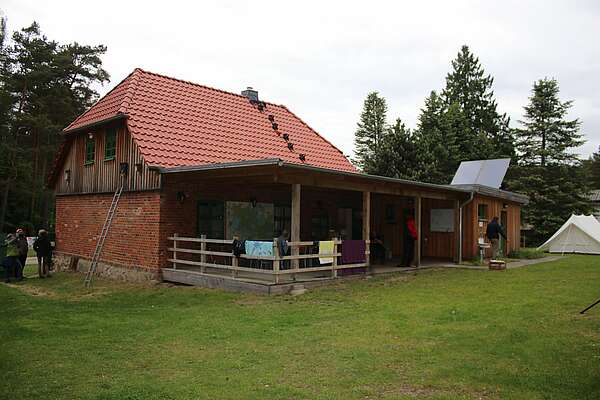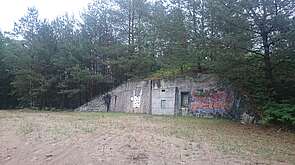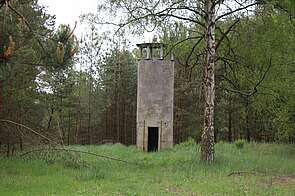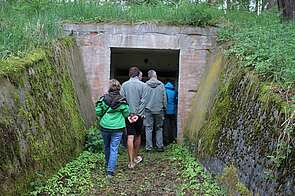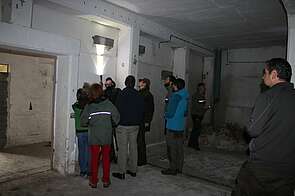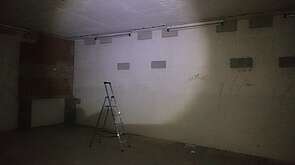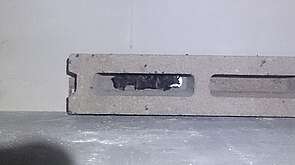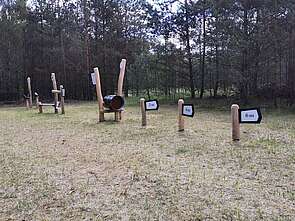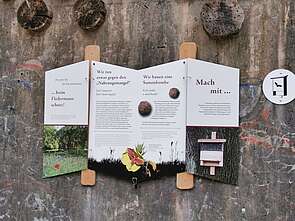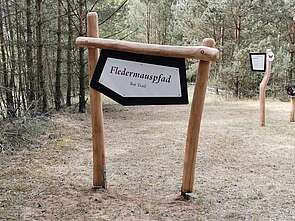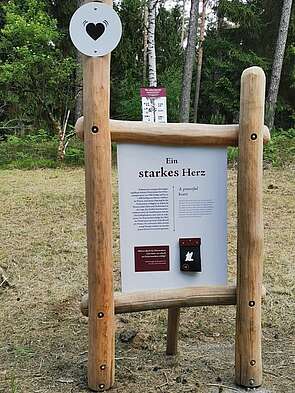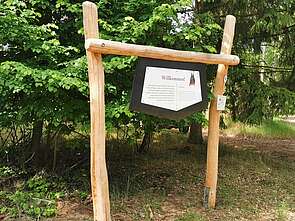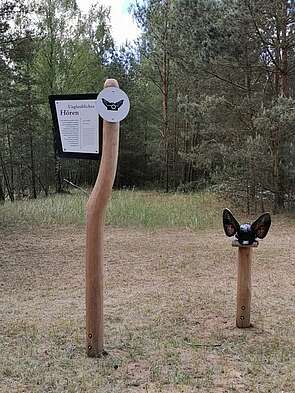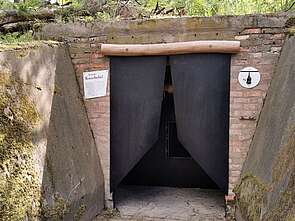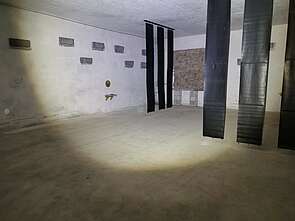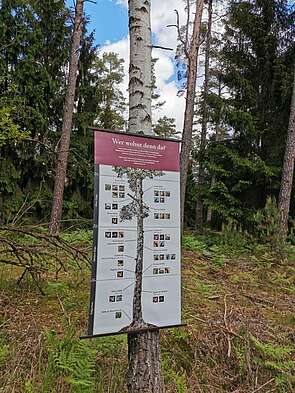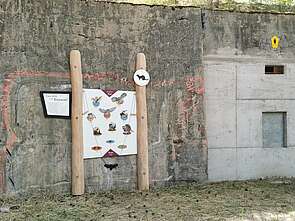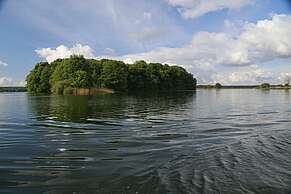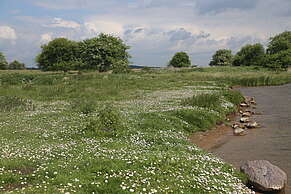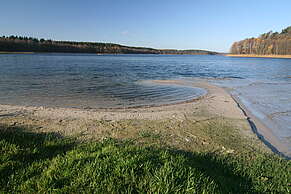Our Citizen Science Station
Nature conservation station Gerhardt Cornelssen House in Wooster Teerofen, Nature reserve Nossentiner-Schwinzer Heide
On request we offer group tours for all ages all year round, in the nature park around our Citizen Science Station in Wooster Teerofen or along our "bat educational trail".
In addition, there are annually recurring guided tours and excursions:
March:Hibernacula counts in the nature reserve. Here you can join a group of scientists and quietly observe and count the bats in their hibernation sites.
Summer: We organise and support several Bat Nights in the summer, during which you can watch live bat catching, bat box checkings or a detector tour and/or a talk about bats.
September: "Life at night": Butterflies, bats & Co. We are hiking on the night of the new moon. Ralf Koch, the head of the nature park, leads through the beautiful world of the night. With as little light as possible, you will get to know one of the darkest places in Germany from its most beautiful side. In this way you learn all kinds of things about the creatures of the night and how important darkness is for us humans too.
The exact dates and everything that is currently happening at FUN can be found at "News and Events". We also offer lectures on various topics. Please contact us.
The Gerhardt Cornelssen House
Gerhardt Cornelssen House
In 2014, friends of the Nature Park Nossentiner/Schwinzer Heide succeeded in establishing its own nature conservation station in Wooster Teerofen by converting an old house. The station was named "Gerhardt-Cornelssen-Haus". Gerhardt Cornelssen, a former head forester and nature conservation officer of the former district of Lübz, had established the first nature conservation station in Wooster Teerofen in 1984 via the forestry administration. This was the beginning of "civic" bat research by committed Thuringian bat researchers and many schoolchildren made their first contact with nature, forests and nature conservation there in their free time. Today the Gerhard Cornelssen House is also the place of our Citizen Science Station. Here we have the necessary infrastructure with which data on bats can be collected and processed, uploaded and evaluated for our online analysis. In addition, there are accommodation facilities and we regularly organise lectures and seminars on the subject of Citizen Science as well as nature and bat conservation.
The "Bat bunkers"
Former military bunkers become hibernation sites for bats
Since 2007, 10 former bunkers of the GDR "Volkspolizei" were converted into hibernation sites for bats. These newly created hibernation sites have been currently occupied by seven species and more than 400 individuals. In autumn and winter, the entering and flying out behaviour of the bats wintering here can be observed via videos from our data pool. Cameras also automatically take pictures of our incoming and outgoing winter guests. Furthermore, all ten bunkers are monitored by light barriers and the bats are automatically counted. This allows us to answer questions such as: How do the populations in the bunkers change? Which bats can be identified in the pictures? If you would like to participate in the analysis of this exciting data, join our Citizen Science project, to which everyone is welcome!
The bat educational trail
With our project funds we were able to develop a bat educational trail in the former military zone. Along several stations you can learn a lot of interesting facts about the bats that can be found here in the Nature Park Nossentiner/Schwinzer Heide. Please understand that due to the sensitivity of the bats and in order to avoid vandalism at the bunkers, the nature trail can only be visited as part of a guided group tour. Please use the contact formular.
Nature Park Nossentiner/Swinzer Heide
Located in the heart of the Mecklenburg Lake District, the Nature Park Nossentiner/Schwinzer Heide covers 365 km². The area is characterised by extensive pine and mixed forests, 60 natual lakes, swamps, dunes and wet meadows where a diverse flora and fauna can be observed. A network of cycling, hiking and riding paths, which lead along small 13th century villages with their historic churches, monasteries and manor houses, extends throughout the entire nature park. In addition, the culture and information centre "Karower Meiler" invites you to visit with an exhibition on the nature park and many events!
The divers landscape was created by the last Ice Age, when glaciers pushed forward from the north about 15,000 years ago, slowly melting and forming the terminal moraine here. The divers natural features and the low human population density (9 inhabitants/km²) are the main reasons for the occurrence of many endangered animal and plant species. Over 140 breeding bird species have been recorded to date. Ninety other bird species occur as migrants and food guests. The entire nature park is a 'European bird sanctuary' (secial protected area). There are about 16 breeding pairs of the white-tailed eagle, 11 pairs of the osprey and 12-15 breeding pairs of the great bittern. Otters populate the entire area. Rare plants grow in dry or wet locations with a low nutrient content, e.g. on the shores of the clear water lakes. Various stoneworts live at the bottom of these lakes in the form of extensive lawns, which are a special gem in the nature park.
However, the extensive clearing of the forest about 250 years ago in favour of the glassworks, tar and lime kilns, brickworks and many wood piles that had been settled here led to the almost complete destruction of the forest. The shortage of wood led to the development of a regulated forestry industry, which gradually rebuilt the forest as a pine forest. Today, about 60% of the nature park area is used as a forest in accordance with a near-natural forestry and has been converted from a pure pine forest into a mixed deciduous forest. Parts of the nature park are to be converted into a forest completely exempt from afforestation by 2020.
This partly wilderness-like landscape is an excellent area to experience modern nature conservation in all its facets and to actively participate in the project.
